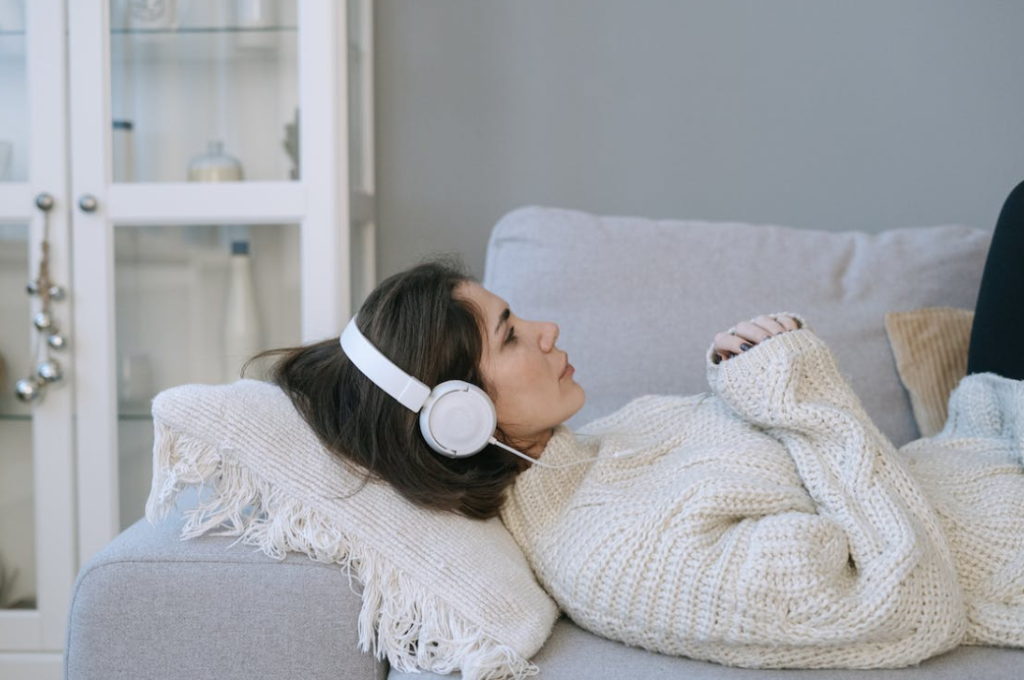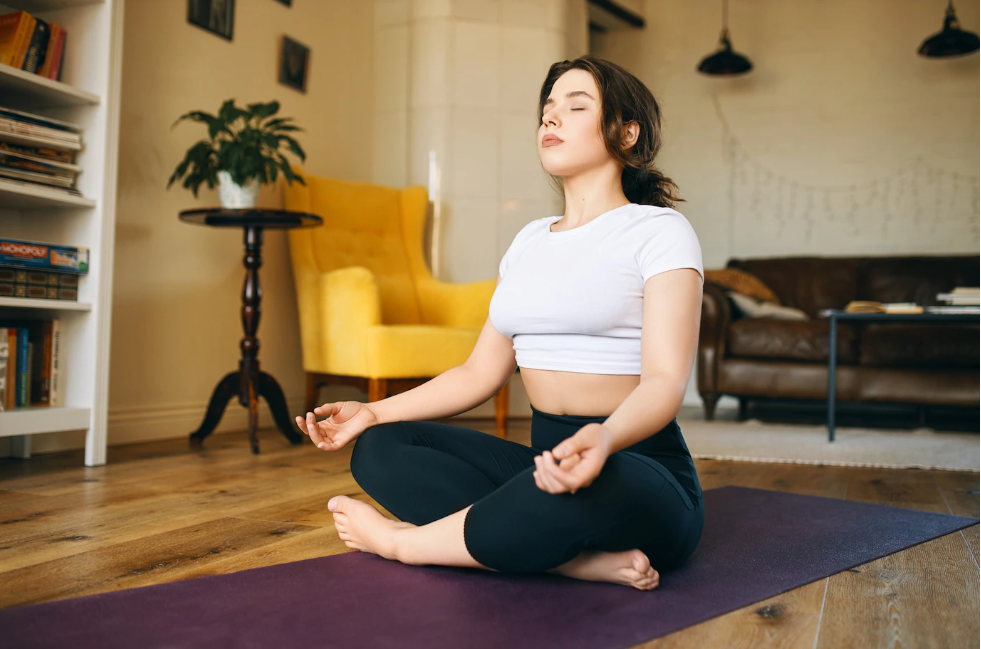How Visualization Helps With Anxiety
Learn how visualization can improve your life by transforming your experience in a positive way.

Selfpause Affirmation App
Download the app to get 1,000’s of affirmation meditations and everything you need to write, record and listen to your own.
Visualization is a powerful way to cope with anxiety. As you practice, you can add new elements to the experience. For instance, you can imagine the sounds that come with being in a safe place or the warmth of the sun. This way, your visualization will be more powerful and useful when you need it most.
Guided Imagery

Guided imagery is a wonderful way to relieve anxiety by helping you see the positive outcomes of different situations. It allows you to imagine what you would like the situation to be like before you actually enter it. For instance, if you are a musician with performance anxiety, you can use guided imagery to relax before a performance. It can also help an athlete or actor run a scene without being nervous. You can also use imagery to help you give a presentation without fear or anxiety.
The guided imagery technique is easy to learn. You can try various scenarios and get help from a therapist if you are having trouble doing it. The therapist can help you brainstorm scenarios and talk about how you could apply them in real life. It will help you to cope better with your anxiety symptoms, relieve your stress, and boost your self-confidence.
Guided imagery is a great technique for anxiety relief and is extremely effective in helping people deal with their problems. It can relieve stress and tension and provide insights and wisdom. It is also free and can be done anywhere. The process involves focusing your imagination on an image of something positive, such as a relaxing beach or the sound of waves lapping at the shore.
Guided imagery is a form of visualization or meditation. Instead of focusing on a single object, you focus on a particular sound or scene. You then imagine that you are in that place. The images you create are positive and can help you cope with problems. It can also help you deal with health issues and learning tasks.
Self-motivation

Visualization is an excellent tool to help control fears and anxiety. Visualizing the desired outcome of a desired action or situation can help you relax and create self-motivation. It can also help you achieve your goals. It is important to be specific and include all of your senses when you visualize.
To begin, select an outcome you are willing to change. This can be a specific goal or a new habit. Then, enter an alpha state of mind (usually through self-hypnosis) or meditative breathing. While you’re in this state, visualize the situation that requires you to change. Notice how uncomfortable your current behavior makes you feel. Then, imagine the scene that will result in you achieving your goal in full color.
You can also try painting a mental picture of a calm, relaxing place. This is particularly useful if you’re in a busy environment or are experiencing an anxiety attack. Find a quiet place where you can focus your attention and try to imagine a calming place. It can be a beautiful, peaceful, and safe place – just make sure you choose one that’s easy to visualize.
Another method of overcoming anxiety is to confront challenging situations and conversations. Visualization exercises help people overcome their fears and confront challenging situations. They can also be helpful for people with generalized anxiety disorder. If your anxiety has started to interfere with your life, it’s best to consult a mental health professional for advice.
Visualization can be used anytime you’re feeling stressed or anxious. It takes a little practice, but you’ll soon become accustomed to the technique. Once you get the hang of it, you can use it whenever you’re in a stressful situation to bring yourself peace of mind and get back on track.
Self-motivation and visualization are two effective techniques for dealing with anxiety. These techniques will help you get rid of your anxiety and improve your quality of life. They can also reduce your stress by up to 65%. Visualization exercises can also help you get a better night’s sleep and recover quicker after exercise.
Relaxing Environment

Painting a mental picture of a relaxing environment can help your brain and body relax. Sit in a quiet place and imagine the place you would like to relax the most. It could be anywhere, but it should be calming, peaceful, and safe. Try to visualize it as easily as possible, and you’ll find it much easier to relax.
Deep Breathing

Visualization is also useful for people who are affected by social anxiety. When they practice this technique, they can enjoy themselves at social gatherings and parties. Compassion meditation is another technique that can help people overcome anxiety. Practicing meditation and focusing on the good feelings people have for one another can also reduce stress and boost mood.
Before beginning visualization exercises, it is important to prepare the environment for comfort. Make sure that you have a quiet room and remove any distractions. Also, remove any heavy jewelry or clothing that restricts your movement. Sit or lie down in a comfortable position. Visualization exercises are most effective when performed with the eyes closed, but you can practice visualization exercises with open eyes.
This coupled with deep breathing techniques can really help to alleviate any stress you might be experiencing because deep breathing is a proven way to reduce anxiety and stress. This exercise helps calm the mind and body by bypassing the complexities of the mind and targeting the body directly. Deep breathing is also helpful for people who have trouble sleeping or are constantly thinking about something negative. It can help to visualize a certain scene or word in your mind while taking deep breaths. This can provide immediate relief. It is best practiced at least twice daily.
Researchers have studied the effects of deep breathing on several patient populations, including those who are undergoing surgery. They found that a study of 4,793 presurgical patients showed a significant reduction in anxiety levels following deep breathing training. This technique has also been shown to have beneficial effects on chronic conditions such as diabetes. In one study, 32 patients with type II diabetes were trained to deep breathe and saw a significant reduction in their Hamilton Anxiety Rating Scale scores. This was compared to the untrained control group, which showed no change in anxiety.
Visualization has the power to transform your experience in a positive way. It helps you cope with anxiety, build confidence, and improve your life. However, it should be used alongside other methods of treatment. You should also consult with your primary care doctor if you’re suffering from anxiety. A psychiatrist or other mental health professional may be able to help you develop a treatment plan to help you reduce your symptoms.
Our Top FAQ's
Visualization, also known as guided imagery or relaxation visualization, is a relaxation technique that involves using your imagination to create calming, peaceful images in your mind. By focusing on these calming images, you can interrupt the cycle of negative, anxiety-provoking thoughts and feelings and bring about a sense of calm and relaxation. Research has shown that visualization can be effective in reducing anxiety, as it activates the relaxation response in the body and can help to lower blood pressure and heart rate.
There are many different techniques for using visualization to manage anxiety. Some common techniques include:
-
Creating a peaceful scene in your mind: Imagine a place that is peaceful and calming to you, and focus on the details of this scene. This could be a beach, a mountain top, or any other place that brings you feelings of calm and relaxation.
-
Using affirmations: Repeat positive affirmations to yourself as you visualize a peaceful scene. For example, you might say to yourself, “I am calm and at peace” as you focus on a calming image.
-
Using guided imagery scripts: Follow a script or recording that guides you through a visualization exercise. These scripts often include descriptions of peaceful scenes and may also include affirmations and other relaxation techniques.
-
Using imagery to reduce specific anxiety symptoms: If you have specific physical symptoms of anxiety, such as racing thoughts or rapid breathing, you can use visualization to help reduce these symptoms. For example, you might imagine yourself taking slow, deep breaths as you focus on a calming image.
Visualization can be used in conjunction with other relaxation techniques, such as deep breathing or mindfulness, to further enhance the relaxation response and reduce anxiety. For example, you might practice deep breathing or mindfulness techniques as you focus on a calming visualization.
While visualization can be an effective technique for managing anxiety, it may not be suitable for everyone. Some people may find it difficult to create clear, detailed images in their mind, which can make visualization less effective for them. Additionally, visualization may not be effective for people with severe anxiety or anxiety disorders, who may need more intensive treatment.
Visualization can be effective for individuals with mild to moderate anxiety, and may be helpful as part of a comprehensive treatment plan for individuals with severe anxiety or anxiety disorders. However, it is important to note that visualization should not be used as a standalone treatment for severe anxiety or anxiety disorders, and individuals with these conditions should seek treatment from a qualified mental health professional.
